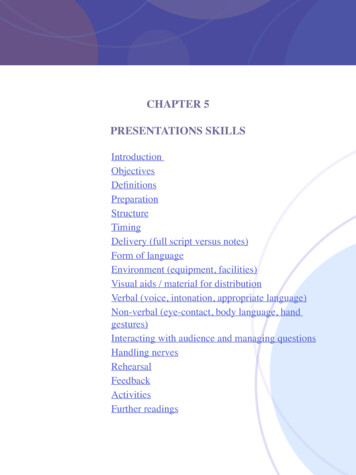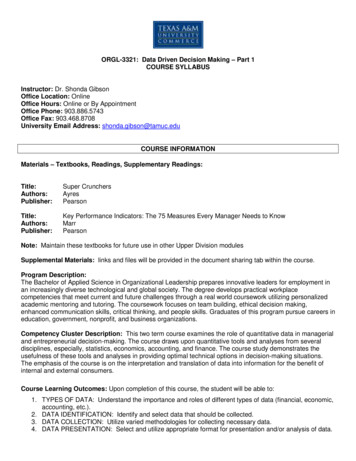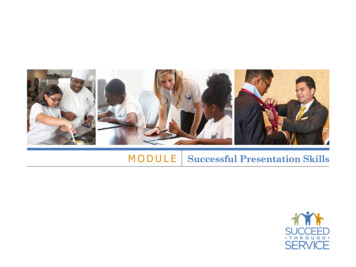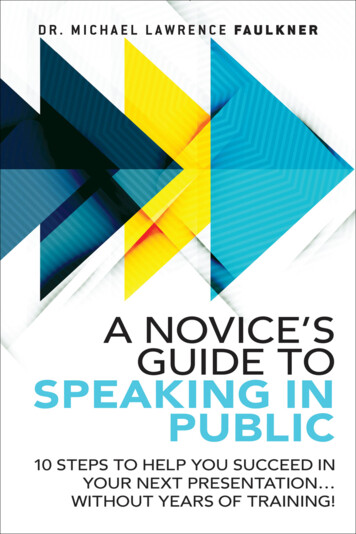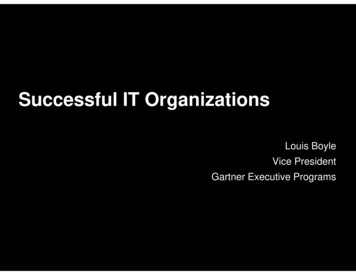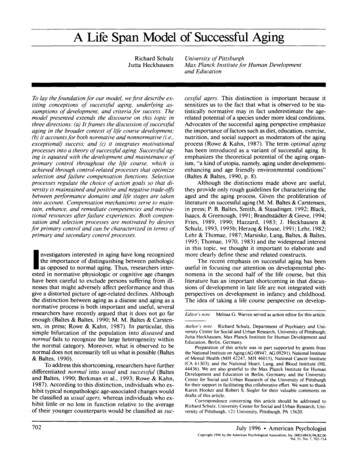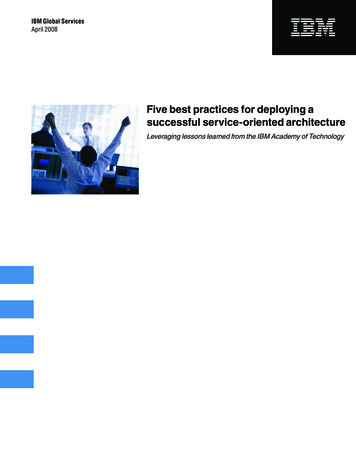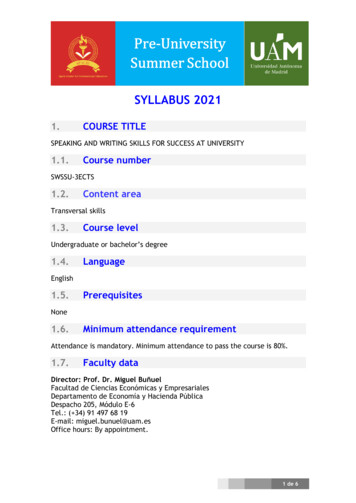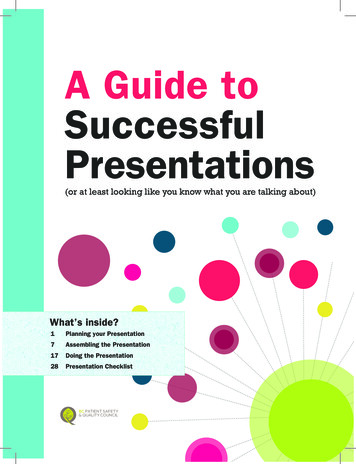
Transcription
A Guide toSuccessfulPresentations(or at least looking like you know what you are talking about)What’s inside?1Planning your Presentation7Assembling the Presentation17Doing the Presentation28Presentation ChecklistBC PATIENT SAFETY& QUALITY COUNCILWorking Together. Accelerating Improvement.
“Speech is power: speechis to persuade, to convert,to compel.”Ralph Waldo Emerson2A Guide to Successful Presentations
Planning YourPresentationYou’ve been asked to give a presentation. Before you jump inand start crafting an outline, do a little preparation in advance.By planning ahead, you can deliver a presentation that is botheloquent and informative. Here are a few things to considerbefore you get started.Know Your PurposeCongratulations! You’ve been asked to deliver a presentation. Why you? Are you a contentexpert? Did you work hands-on with this project, or were you just in the right place at theright time? Having a clear understanding of the purpose of the presentation will guide yoursubject matter and make it easier to prepare.General Key MessageSpecific Key MessageUpdate on theCoffee Situationfree coffee results in greaternight shift productivityWhat is the key message of your presentation?The key message you are delivering needs to be clear. Write your key message in simpleterms and tape it over your work area as you are preparing your presentation. At any time,you can look up and see how the graph/narrative/illustration you are working on ties into your key message. It should be specific (e.g.: free coffee results in greater night shiftproductivity, which is good for our site) and not general (e.g.: update on the coffee situation).Do not start creating your presentation until you know your key message.What is your motivation?Why are you doing this? Are you informing? Reporting? Calling to action? Part of your purposeis to create interest and movement around your topic. Do you want people to walk awaysaying, “Wow, that was interesting,” or do you want them to leap up and join your cause? Apresentation that is meant to report a recent research finding will differ greatly in both contentand tone than a presentation that is meant to recruit people to be a part of your project.A Guide to Successful Presentations1
Know Your AudienceWho will be attending your presentation? Thisknowledge will guide your planning. Knowing youraudience members will allow you to tailor yourcontent and delivery to ensure that they get themost out of your presentation.“If you can’t write your messagein a sentence, you can’t say it inan hour.”Dianna BooherHow many people will be attending your presentation?Audience size will affect how interactive your presentation can be, what kind of equipmentmay/should be used (such as microphones), the location of the meeting and, quite possibly,your nerves. Try to find out approximately how many eyes will be looking back at you.Presenting to a larger group will often have a more formal tone – you won’t know everyoneand may need to provide more background on yourself and your topic. Small, roundtablepresentations may not even require you to stand. If you need to stand up during yourpresentation, make sure you stand up when you rehearse (and likewise if you’ll be sitting).Have you met these people before?Presenting to a familiar group of colleagues will feel different than presenting to a group ofexecutives you have never met. You may not need to introduce yourself if your audience ismade up exclusively of people you see every day, but don’t assume that everyone knows whoyou are and what you do.What level of understanding does your audience have?Assessing existing knowledge can sometimes be difficult but it’s important to try to know theaudience’s baseline understanding of your topic. This knowledge (along with other factorssuch as time and scope) will dictate the level of detail you will need to go into during yourpresentation. A presentation to a novice group will look significantly different than a followup presentation to an expert group. It is important to briefly summarize key topics or themes(even to an expert group) to ensure everyone is on the same page but prevent boredom bydiving into new and interesting topics as quickly as possible.How will the content of this presentation affect your audience?Understanding the impact of what you are about to present will allow you to anticipatequestions, elaborate on key concerns, or brace for an uproar. Presenting a new protocolwill garner a much different reaction from those whose daily work has to change than fromothers who are not directly affected. You may need to leave more time for questions, go intospecifics in certain areas, or provide handouts.2A Guide to Successful Presentations
The Importance of TimeOften when presenting you have either too much time or not enough time. Working diligentlywithin your allotted timeframe will result in the ‘Goldilocks’ of presentations – everything willbe just right.How much time will I have?Try your best to get an accurate answer to this. Youare going to plan your slides, rehearse your spieland leave just enough room for questions suddenlyhaving an extra 10 minutes will make you regretcutting that one awesome slide that just didn’t fit.Worse yet is a beautifully crafted presentation givenin fast forward because you are on the agenda for15 minutes, not 30 as you had thought. Alwaysconfirm that the amount you were told initially is theamount that shows up on the agenda. If there is adiscrepancy, clarify and edit your presentation asneeded prior to your arrival.PECHA KUCHAThink you need lots of time and slidesto get your point across? Think again!Pecha Kucha is a presentation stylewhere there are 20 slides shown for20 seconds each, making the entirepresentation just 6 minutes and 40seconds long! These presentationshave proven to be very effectiveand popular – developing into aworldwide presentation community.Are you brave enough to give it a try?Check it out: www.pechakucha.orgHow much time do I need?The amount of time you are allotted and the timeneeded to present the requested materials are“There are always threesometimes mismatched. You need to decide if youspeeches, for every one youcan accurately present the requested topic in theactually gave. The one youtimeframe you were given. If not, you either need topracticed, the one you gave,negotiate more time or scale down your content. It is and the one you wish you gave.”perfectly acceptable to only present a ‘piece’ of yourDale Carnegieproject if you don’t have enough time to present theentire topic.How much time should I allocate for questions?There is no right answer for this question, other than to say that you should leave SOME timefor questions. There is nothing worse than hearing a thought-provoking presentation thatleaves you wanting more, and not having time to interact with the presenter. Knowing youraudience will help narrow down the timeframe for questions. A small group that is familiarwith the topic may have lots of questions. A large, forum-style presentation may only allowfor a few questions from the crowd. If your topic is new and may have a big impact on youraudience, be prepared for a lively back-and -forth discussion at the end of your presentation.A Guide to Successful Presentations3
Respect the clockBe respectful of how much time you are given and stay within it. It’s not okay to go over yourallotted time just because you are the last presenter before a coffee break. Messing withcoffee breaks is ALWAYS a bad idea. You also don’t want to force the person after you to alterhis/her presentation because you went over time, particularly if you spent those 20 minutestelling a story about your cat. It is also good to know where you fall in the agenda – if you areright before lunch you may need to keep your topic lively to maintain audience attention.Tying It All TogetherTry your best to tie your topic back into the general theme of theagenda or conference. Aligning themes, values and content withthe larger picture will make your topic integrate more seamlesslyinto the content for the day. You want to be remembered for howyou inspired, not how out of place your presentation seemed.Additionally, try not to duplicate content from other presenters,especially when presenting within your own organization wheremultiple people work on the same projects. Avoid contradictingcontent presented by others. That is not to say you can’t presentyour experience or results, just don’t call anyone out for being wrong.One final note about understanding why you are there you wantto present on what your audience wants to hear. Believe it or not,your audience may not be interested in how you saved 35 centsper surgical dressing by haggling with the distributer. Give thecrowd something useful, and you can add in extras later.“It usually takes me more thanthree weeks to prepare a goodimpromptu speech.”Mark Twain4A Guide to Successful PresentationsWrite it downfor retentionWant youraudience toreally rememberwhat you said?Get them writing!When peoplewrite, theirbrains becomemore activelyengaged fromthe motor action,and retentionincreases.
SUCCESSful Principles for making it stick*S: Simple — find the core of any ideaU: Unexpected — grab people’s attention by surprising themC: Concrete — make sure an idea can be grasped and remembered laterC: Credible — give an idea believabilityE: Emotional — help people see the importance of an ideaS: Stories — empower people to use an idea through narrative*Reference: Made to Stick by Chip & Dan HealthWhat?Who?How Long?A Guide to Successful Presentations5
“They may forget what you said,but they will never forget how youmade them feel.”Carl W. Buechner6A Guide to Successful Presentations
Assembling YourPresentationAfter some careful preparation, you are now ready to start puttingyour presentation together. Choose your content carefully anduse these suggestions to help create an effective and powerfulvisual display.Choosing the ContentYou were asked to deliver a presentation because you are (hopefully) an expert on atopic. Choosing what to include in your presentation, however, can be incredibly difficult.Understanding your key message should keep you focused, but what should actually go intothe final presentation?So What?During the preparation phase you will have determined the purpose for your presentation. Allyour content should tie back to that purpose – and everything you include should add valueto the presentation. Be purposeful when choosing content; ask yourself “does this belong?”and “is this the best way to tell the story?” While reviewing your content, ask ”so what?” –your answer should be “it is related to my key message.” If it isn’t related, you can probablydelete it from the presentation. This technique works especially well with graphs - if the ‘sowhat’ isn’t obvious, then your graph isn’t doing a very good job of displaying your data.The Devil is in the DetailsDon’t get bogged down in details. Remember your audience when considering the level ofdetail you get into. If you are presenting to a group that wants to recreate your project, youwill include more detail than you would for an audience that only needs a high-level overview.Give people enough information that they understand the context but not so much that ittakes away from the key message. The less you say, the more they will remember. Keep inmind that the aspect of your project that excites you (and, therefore, might want to discussin great detail) is often not what might excite your audience. Try to take advantage of thatenthusiasm by using it throughout your presentation.“No one ever complains abouta speech being too short!”Ira HayesA Guide to Successful Presentations7
Creating a NarrativeThe purpose of any presentation is to inform, inspire and energize your audience. One of thebest ways to connect with your audience intellectually and emotionally is to use a narrativeapproach; tell your audience a story. Your audience needs to know the following: where arewe now, where do we want to go and how are we going to get there. These elements helpcreate a flow to your presentation and also tap into your personal motivations for beinginvolved in the project. If you are uninspired by the content you are presenting, you canbet your audience feels the same way. Think about engaging your audience and building aconnection with them.PowerPoint TipsMany use PowerPoint as the basis of their presentations, and itcan be a great tool when used appropriately. Slides should be asupplement to the content you are speaking about; they are not astand-alone presentation. Here are 5 tips that will improve the lookand flow of your presentation.Stick to standardfonts – othercomputers maynot be able toread unique fonts1. Keep it simple: The less clutter you have on your slide, the more powerful your visualmessage will be. Don’t fill white space with fancy backgrounds or logos - it can make theslide difficult to read. Exotic accents that look festive on your small computer can be aheadache-inducing disaster on a large projection screen.2. Don’t take a bullet for your presentation: Limit the text and bullet points on yourslides. Slides are not meant to be a teleprompter script for your presentation, and youraudience will tune you out if you read directly from your bullets. Have no more than threebullet points or sentences on a slide. Better yet, keep it down to a few key words; only usefull sentences when quoting.3. Leave neon in the 80s where it belongs: Choose font and colour wisely: Yourpresentation should have a font and colour scheme; consider using a template and keepit the same throughout the entire presentation. Avoid script, italic and novelty fonts –stick with professional, easy to read sans-serif fonts. Many seasoned presenters suggestthat 30 point is the smallest font to use. Avoid red or dark font on dark backgrounds.Lighter backgrounds (with dark text) work best in bright environments.4. No one will laugh at a blurry picture of a squirrel in a tuxedo: Use high qualityimages. Graphics that are pixelated and hard to read will distract from your presentation.8A Guide to Successful Presentations
Visuals should match your presentation and addvalue to your slides. Avoid clip art and stock imagesavailable with your presentation software – yawn.Everyone has seen them before.POWERPOINT SLIDESAND HANDOUTSPowerPoint Slides generallydo not make good handouts.Why? It’s like giving away thepunchline before you tell thejoke—people just can’t helpthemselves and will oftenflip ahead to see what’scoming next.5. Keep your audience interested, but don’t makethem dizzy. Move through a slide every 30s to 3minutes to keep interest and allow time to processinformation. Split content onto multiple sides to keepa nice flow. Avoid frequent and distracting transitions,use these only for emphasis.Presentation TipsSo what can you do instead?Jargon & AcronymsOne of the big mistakes that both novice and seasonedpresenters make is using jargon and acronyms during theirpresentation. It’s best to avoid using jargon and acronymsaltogether, with the following exceptions: Print your key informationin a different format, likeMicrosoft Word. Systematically leaveout certain pieces ofinformation in yourhandout so that theaudience is forced to payattention to you. Distribute your handoutat the end of yourpresentation.1. 100% of the people in your audience use the samelanguage – if you are CERTAIN that you are all on the samepage (ie: you have all been working on the same project for6 months), it only makes sense to speak the language.2. The ‘jargon’ you are going to use is integral to yourpresentation and you are going to use it repeatedly– in that case, define the term at the beginning of thepresentation so that everyone understands how you areusing the word.3. The main topic content of your presentation is oftenreferred to as an acronym – if you are presenting abouta project called “Learning in Longterm Adult Care” youmay wish to refer to it as the LILAC project. Spell it out thefirst time and let your audience know that it is commonlyreferred to by an acronym and then carry on.*only do this for acronyms you will use more than 5 times during yourpresentation If you are only going to say it twice, just use the full form“If you don’t knowwhat you want toachieve in yourpresentation youraudience never will.”Harvey DiamondA Guide to Successful Presentations9
NotesUse presentation notes if you find them helpful. Now that you’re not using bullets as ateleprompter, you may need to have your speaking points on paper in front of you so thatyou can refocus and orient yourself if you get flustered or off topic. Unfortunately, readingoff your speaker notes is only a slight improvement over reading off the slides. Think of yournotes as key points you don’t want to miss and specific details that you want in front of youso you get them right. By rehearsing and preparing, you should only need to glance at yournotes occasionally.Have details in your notes that you anticipate referring to during the question period butdidn’t make the cut for the core presentation. You may need them, you may not but manypeople take comfort in having the information in their hands just in case.Contact Info & ReferencesIt is common practice to include your contact info on a slide near the end of thepresentation. You may also include members of the project team, or key contacts at yourorganization with permission.References are also often included throughout and at the end of a presentation to give creditfor content that is not yours. Insert citations right on the slide or include a reference list at theend. The reference list may also include helpful websites, articles and resources that may bevaluable to others who want to investigate your topic further. Realistically, very few people inyour audience are going to start scribbling down all your references when you whiz by the slideat the end of your presentation, so consider sharing your slides or including a handout.What Not to Wear – A Style GuideMatch your attire to the tone and style of the event. Consider what your audience is wearingand ensure you’re comfortable.Wearing a suit when speaking to an audience full of people wearing t-shirts and jeans maythrow you off your game and make you lose credibility. Be aware that while your day to dayjob may require you to wear the most shapeless and pyjama-like uniform known to man(a.k.a. scrubs), kicking it up a notch for a conference may be a good idea.Be comfortable! Think about the venue and your personal preferences. Conference rooms arenotoriously either too hot or too cold and you want to be at ease. Layers are usually a goodidea. Don’t get so carried away with matching the style of the conference that you don’t feellike yourself. Presenting is hard enough without struggling against a tie or heels that you wouldnever wear under any other circumstance. Be aware of how you are displaying yourself visuallybut BE YOURSELF!10A Guide to Successful Presentations
Rock Your PresentationEach presenter will have his/her own method of preparing for their presentation.You may find a checklist useful, especially if the concepts in this section are new.10 Ways to Ruin a Presentation10 Ways to Rock a PresentationJump right into your content withoutintroducing yourself or your topicSketch out an outline for your presentationon paper before you start making slidesDon’t worry about what your audienceis interested in, just talk about whatyou think is most importantPay attention to your audienceand respond their signalsCram your slides with lots of bullets,text, data, and picturesSimplify, simplify, simplifyUse a lot of jargon and constantlyrefer to theorists and colleagues inyour fieldUse examples people can relate towhen explaining complex ideasDon’t bother practising to get morecomfortable and make sure thetiming is rightPractice, practice, practiceTalk all about yourself and youraccomplishmentsHave fun with it - your enthusiasmwill inspire others!Don’t worry about having crediblesources for your informationKnow your content inside and outFace the screen instead of the audienceand read the slides word for wordBe purposeful with body languageand tone of voiceGet totally sidetracked and start talkingabout something completely differentAnticipate any questions you maybe askedAssume you won’t have anyunexpected technical problemsIf you can, check out the venueahead of timeA Guide to Successful Presentations11
Data DisplayThe thought of creating, presenting and explaining data (especially displayed in graphs)strikes fear in the heart of many presenters. Here are some tips for displaying data.Basic Principles of Data DisplayFirst a graph do you really need one? Don’t use a graph when you can plainly explain thedata in a sentence. Consider using your data table instead if it is easier to interpret at a glance.If you do include a graph, it should be a stand-alone representation of your work. A clearpicture is worth a thousand words, so you shouldn’t need many words to explain your graph.Keep it simple and get to the point. Highlighting key elements with clarity will draw theviewer’s attention to your key message.Choosing the Right GraphVisual data display is an art in itself and a well-designed graph can be a masterpiece tobehold. While you may not create the bar graph Mona Lisa, you can certainly display yourdata in a clear and concise way.Bar graphs are the most common type of graph seen and can be displayed both verticallyand horizontally. Columns of bar graphs represent amounts or value of a selected variable.Bar graphs allow for easy comparison of data, especially when differences are large. Theyallow for comparison of data over time, such as before/after or by year, but are not aseffective when measuring frequent time intervals.Line graphs are most commonly used to display data over time. This type of graph makes iteasier to see smaller variations over time and to display change for multiple groups over thesame time. There should be an equal space on the horizontal (x) axis between each point.For example, you cannot start plotting your graph in monthly intervals, than switch to dayspart way through the graph. It is misleading.Run Charts are commonly used in quality improvement displays and look very similar to linegraphs. In fact, it is a line graph with one notable addition – the median line.Control Charts are a run chart with upper and lower limits to indicate if the system is stableor ‘in control’. In quality improvement measurement, many people start with a run chart asit only contains a few data points. Once there are more than 12-15 points, you can create acontrol chart.12A Guide to Successful Presentations
Scatterplots or X-Y graphs are used to show relationships between variables (also calledcorrelations). These graphs are useful with large datasets with an anticipated relationship. Abest fit line is used to determine the strength and direction of the relationships.Pie charts are a popular method to display percentage data, but they can be more difficultto interpret than bar graphs (which can be used to display the same data). They require thereader to mentally calculate the relative areas of each ‘slice’ to determine the figures theyrepresent. When the differences are not large, this estimating is difficult to do. In thosecases, it is best to use a bar chart to display the same data.White SpaceAfter selecting and creating the appropriate graph for your data (and possibly eating apiece of pie) you may be looking at a chart that is squished, colourless, and full of squigglylines. While the aim of this booklet isn’t to educate you in all the nuances of your preferredspreadsheet program, here are some tips on improving the look of your graph.Use the right amount of white space to make a graph easy to read. For bar charts, leavesome space at the top, so that the highest bar is located about 75% of the way up yourvertical axis. For line graphs, have your graphed data take up 50% of the space on the graphand include white space on either side. However, don’t sacrifice the appropriate scale (seebelow) to create white space. And white space should be white; avoid fancy backgrounds andremove gridlines.KEEP IT SIMPLEBe ruthless with your content! Simpify, simplify, simplify. Delete anything that doesn’tabsolutely have to be said or displayed.Go through your presentation several times and look for extra or unnecessary information.If it doesn’t support your key message, delete it.A Guide to Successful Presentations13
ScaleThe scale should match your data. If you are looking at the number of cat toys removedfrom the toy box each week by your feline friend, the minimum possible value is 0% and themaximum is 100%. Mr. Kitty cannot remove more than all of the toys (or fewer than none), nomatter how awesome he is. Your scale may not need to span the entire possible range if yourdata centers around the median. Perhaps 33% to 66% would work.Common scale is another principle of data display. If you are going to compare two graphs(say ice cream flavour consumption between two households) you want to make sure that thescales are the same – especially if you are going to put them side by side. Having differentscales in misleading and can lead to incorrect interpretation by your readers.Using All the Fancy Extras – the Perils of Exploding Pie ChartsMost data programs give you the option to spice up your graph by adding 3D graphics andfancy animations. While these options can be amusing and eye catching, they often result in agraph that is difficult to read and makes it more difficult to get your point across. Simplicity isbetter. Unless you are creating a hilarious office gag reel, no good comes of an exploding pie.Hit “B” for blank – whenPowerPoint is in slideshowmode, the B key will switchthe screen to black. This isa quick, easy, way to pauseyour slides for discussion.(Or if you want a whitescreen – use the W key).14A Guide to Successful Presentations
HandoutsMany novice presenters try to cram all their information onto slides so they can circulatethem as a stand-alone document. If you really need to share all the great things youknow but can’t deliver all of it in your presentation, create a handout to include with theconference program or attach to meeting minutes. Include reference lists and your contactinformation.RehearsingThe last three steps in preparing for a presentation are practice, practice and practice.The importance of rehearsing your presentation cannot be stressed enough. Start bysitting in front of the computer to run through transitions and work out any kinks that mayshow up when you run through the presentation in ’view slideshow’ mode. Do at least onerehearsal in front of a live audience. Your practice audience does not need to have a goodunderstanding of the content, but they should be able to provide some feedback on yourpresentation style. Ask them to take note of how many times you say “uhhh” or “ummm”,check your timing, and give some overall feedback on eye contact, your voice and posture.If bribing your friends with free cookies still doesn’t give you a practice audience, video oraudio record yourself. It can be a little painful to listen to yourself on tape (or the digitalequivalent) but you can gain a lot of insight. You may think you sound peppy and energeticonly to realize, upon listening the recording, that you sound like Eeyore. If this happens, bemore confident and energetic than you actually feel.A final technical rehearsal is ideal if you can arrange it. Arrive early at your venue to makesure your slides have been loaded onto the computer. Walk around the room and considerwhere you will be best viewed by the audience. If you are going to be using a podium, makesure that it is the right height. Practice using the remote to advance slides and use the laserpointer correctly. No matter how prepared you are, shining the laser pointer in the eye ofthe company CEO might not be a good idea. Check that embedded videos play and that theaudio works; it can really throw a wrench in your presentation plan if you have to search for anew link. You don’t have to run through the entire presentation, just get comfortable with theroom and technical aspects.“Best way to conquer stage fright is toknow what you’re talking about.”Michael H MesconA Guide to Successful Presentations15
“There are only two typesof speakers in the world.1. The nervous and 2. Liars.”Mark Twain16A Guide to Successful Presentations
The Art of ActuallyDoing A PresentationLast but not least, it is time to get up in front of your audience.Your preparation has brought you this far and there is a bit moreinformation that can contribute to successfully completingyour mission: presenting your presentation.Can You Hear Me Now? Tips for Public SpeakingStanding up in front of any sized group can strike fear into the heart of many presenters.Take comfort in knowing you are not alone and your audience wants you to succeed!1. Be prepared: This comes back to practice, practice and more practice. Being familiar withyour content will help ease your nerves on presentation day. Know the order of your slidesand what is coming next – you shouldn’t need to use the screen as a prompt.2. Take a deep breath: You may get a surge of adrenaline and feel your heart start racingin the minutes before your presentation. This is a good time to take a deep breath andremember that the audience is your friend. You were asked to come speak people wantto hear what you have to say. Take a moment to organize your thoughts, have a sip ofwater and then launch into your opening words.3. Stand Strong: Take a position in a place you feel comfortable. If you are at a podium, standtall and ensure the microphone is in front of your mouth (and not totally obscuring your face).If
Pecha Kucha is a presentation style where there are 20 slides shown for 20 seconds each, making the entire presentation just 6 minutes and 40 seconds long! These presentations have proven to be very effective and popular – developing into a worldwide presentation community. Are you brave
